Explanation Of Hair Loss And Its Prevalence
Hair loss, also known as alopecia, is a common concern for both men and women across the globe. It can be attributed to various factors such as genetics, hormonal imbalances, medical conditions, or even certain medications.
One prevalent form of hair loss—Androgenetic Alopecia—affects both genders and is primarily influenced by genetic predispositions. This condition explains why some individuals experience hair thinning sooner than others in their lives even when they follow similar lifestyles and share comparable health statuses.
The best way to address hair loss depends on its root cause; however, multiple natural ingredients for hair growth and thickness have been identified that aid in preventing or reversing this issue.
Brief Overview Of The Stages Of Balding
As the natural process of hair growth and shedding continues, many individuals may experience various stages of balding. These progressive stages are often a result of factors such as genetics or hormonal imbalances and can impact both men and women.
To help identify the specific stage of balding one might be experiencing, experts use two major scales: the Norwood-Hamilton Scale for Men and Ludwig Scale for Women. Both systems outline distinct levels that represent progressive degrees of thinning or receding hairlines.
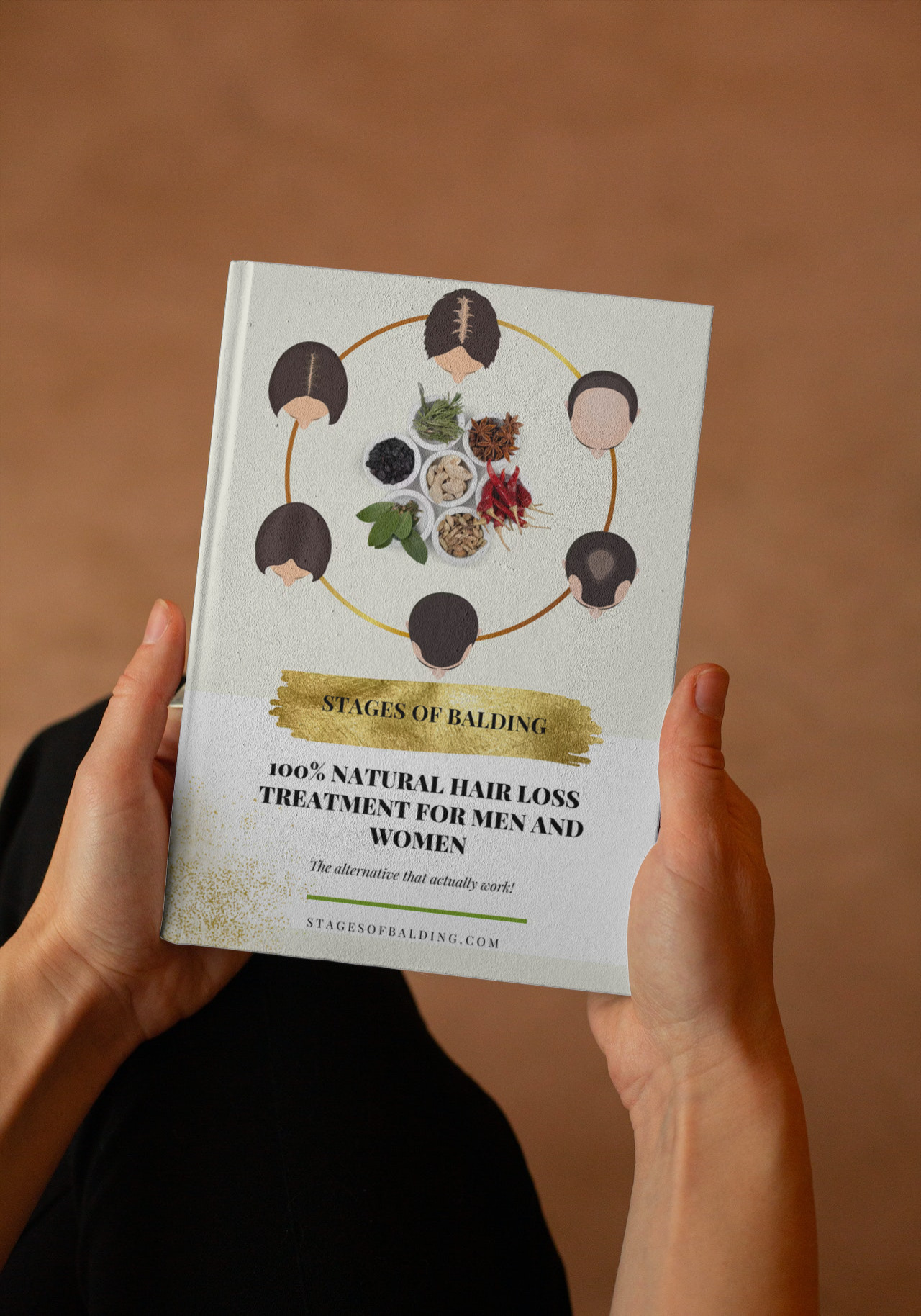
Understanding Hair Growth And Hair Loss
Hair growth is a complex process that involves the hair follicles cycling through various stages of growth, rest, and shedding; however, several factors can disrupt this cycle and cause hair loss.
Anatomy Of Hair Follicles
Understanding the anatomy of hair follicles is crucial in learning about the stages of balding and finding effective natural treatments for hair loss. Hair follicles are tiny, pocket-like structures embedded in the skin, housing the root of each individual hair strand.
Each hair follicle consists of several parts: the papilla containing blood vessels that deliver essential nutrients needed for growth; sebaceous glands which produce oil (sebum) to keep the growing strands moisturized; and an outer sheath called connective tissue surrounding and protecting these components.
Damage to any part of a hair follicle can result in weakened or thinning strands and may ultimately lead to various stages of balding.
Hair Growth Cycle
The hair growth cycle is an intricate process that consists of four distinct phases: anagen, catagen, telogen, and exogen. During the anagen phase, which can last two to seven years, your hair actively grows at a rate of about half an inch per month.
As the cycle progresses into the telogen phase, lasting about three months, hair strands enter a resting state where new hairs start forming underneath them. Finally comes the exogen phase – or shedding phase – where older hairs fall out naturally while making way for newer ones.
It’s important to understand this continuous process because disruptions in any of these stages may lead to temporary or permanent hair loss due to factors such as hormonal changes, medication side effects or medical treatments like chemotherapy and radiation therapy.
Causes Of Hair Loss
Hair loss can occur due to a variety of factors, including genetics, age, hormonal changes, and underlying health conditions. Androgenic alopecia is the most common form of hair loss in both men and women, and it is caused by a genetic predisposition that leads to sensitivity to dihydrotestosterone (DHT), a hormone that causes hair follicles to shrink gradually.
Other causes of hair loss include nutritional deficiencies such as iron deficiency anemia or thyroid problems like hypothyroidism. Stress, medications such as chemotherapy drugs and birth control pills, certain hairstyles like tight braids or ponytails, and autoimmune diseases like Alopecia Areata can also lead to hair thinning or baldness.
The Stages Of Balding
The Norwood-Hamilton Scale for men and the Ludwig Scale for women are discussed in detail to explain the different stages of balding, from a receding hairline to complete baldness.
Norwood-Hamilton Scale For Men
The Norwood-Hamilton Scale is widely used to measure the progression of male pattern baldness. This scale has seven stages, from minimal hair loss at stage one to complete baldness on the crown and front of the scalp at stage seven.
Stage two marks the beginning of visible hair loss with a receding hairline, while stages three to five involve significant thinning or balding on the top and sides of the head.
By stage six, only a narrow band of hair separates the front and crown areas, leading to an almost fully bald appearance.
Ludwig Scale For Women
The Ludwig Scale is one of the most commonly used methods to determine the severity of hair loss in women. It ranges from stage 1, which is characterized by minimal hair thinning, to stage 3, which involves significant hair loss and bald patches on the crown area.
Unlike male pattern baldness, female pattern baldness or Androgenic Alopecia doesn’t follow a specific pattern but can cause diffuse hair loss throughout the scalp. According to trichologists, less than 1% of women experience severe hair loss as per this scale.
In-depth Description Of Each Stage
Understanding the different stages of balding is crucial when it comes to identifying and treating hair loss. For men, the Norwood-Hamilton Scale is typically used to classify male pattern baldness into seven distinct stages.
Stage I represents little or no hair loss, while stage VII marks a nearly complete absence of hair on the top of the head. On the other hand, women experience female pattern baldness that tends to follow a more diffuse thinning process rather than a noticeable receding hairline.
It’s important to note that not everyone can be classified into these standard scales since there are various types of alopecia with unique patterns or distribution of hair loss in both genders.
Natural Hair Loss Treatments
Explore natural remedies for hair loss, such as essential oils and herbs, the benefits of scalp massage, and lifestyle changes that can prevent balding.
Importance Of Nutrition And Diet
Nutrition and diet play a significant role in maintaining healthy hair. A deficiency in essential nutrients can lead to hair loss, so it’s important to ensure that you’re getting enough of each vitamin and mineral.
Foods that are rich in iron, zinc, vitamins A, B, C, D and E have been linked to improved hair health. Protein is also crucial as it helps the body form keratin – the building block for our hair strands.
Additionally, sugar consumption can contribute to hormone imbalances which lead to inflammation and DHT production- all culprits of hair loss.
Keywords: how to regrow thinning hair female; best medicine for hair fall and regrowth; best natural ingredients for hair growth; ayurvedic herbs for alopecia
Natural Remedies With Essential Oils And Herbs
Essential oils and herbs offer a wide range of natural remedies for hair loss. For instance, peppermint oil can help to invigorate the scalp and stimulate blood circulation, promoting healthier hair growth.
Rosemary oil has also been shown to have anti-inflammatory properties that help to reduce stress on hair follicles caused by inflammation. Additionally, saw palmetto is a popular herbal remedy known for its ability to block DHT, a hormone responsible for male pattern baldness.
Researchers believe that applying saw palmetto topically or taking it orally may lower the levels of DHT in the body, reducing hair loss over time.
Benefits Of Scalp Massage
One natural hair loss treatment that has gained attention in recent years is scalp massage. Massaging the scalp can help stimulate blood flow to the hair follicles, which may promote hair growth and thickness.
While research on the effectiveness of scalp massage for treating baldness is limited, a small Japanese study found that standardized scalp massages increased hair growth rate significantly.
Regularly massaging your scalp with essential oils or simply using your fingertips can be an easy and relaxing way to potentially boost your hair health without resorting to medication or surgery.
Lifestyle Changes To Prevent Hair Loss
Making certain lifestyle changes can help prevent hair loss in both men and women. Incorporating a balanced diet that includes essential nutrients such as Vitamin D, Biotin, Zinc, and Iron can promote healthy hair growth.
Additionally, regular exercise can reduce stress and increase blood flow to the scalp, which may also contribute to healthier hair.
Aside from dietary improvements and staying active, managing stress levels is crucial when it comes to preventing hair loss. High levels of stress have been linked to an increased risk of alopecia areata or telogen effluvium – both types of temporary hair loss caused by physical or emotional stressors.
Medical Hair Loss Treatments
Explore FDA-approved hair loss medications, types and benefits of hair transplant surgery, low-level laser therapy, topical finasteride and minoxidil, and DHT blocker supplements to learn more about effective treatments available for preventing hair loss.
FDA-Approved Hair Loss Medications
There are a few FDA-approved medications that can help treat hair loss, including Minoxidil and Finasteride. Minoxidil is applied directly to the scalp and has been approved for both male and female pattern baldness.
It helps increase blood flow to the scalp, which in turn promotes hair growth. Finasteride, on the other hand, is an oral medication only approved for men with male pattern baldness.
It works by blocking the conversion of testosterone to dihydrotestosterone (DHT), which is known to contribute to hair loss.
Types And Benefits Of Hair Transplant Surgery
One of the most effective options for hair restoration is hair transplant surgery. Also known as hair replacement or transplantation, this procedure involves moving healthy follicles from one area of the scalp to balding or thinning areas.
There are different types of hair transplant surgeries available, including Follicular Unit Transplantation (FUT) and Follicular Unit Extraction (FUE). FUE is a less invasive option that involves removing individual follicle units and placing them in the desired area.
It’s important to note that the success of a hair transplant surgery depends on various factors such as age, stage of balding, health status, and expectations. Earlier stages tend to show better results with less extensive treatment required.
In addition to surgical options, there are also medical treatments available like finasteride and minoxidil which can be recommended based on the stage of balding.
Low-Level Laser Therapy
Low-Level Laser Therapy (LLLT) is a popular natural hair loss treatment option for both men and women experiencing Androgenetic Alopecia (AGA). This safe and effective modality uses low-level laser light to stimulate hair regrowth by improving circulation and encouraging cellular metabolism.
LLLT works by increasing blood flow to the scalp, which delivers nutrients needed for healthy hair growth. One key advantage of LLLT is that it has no known side-effects, making it an attractive natural remedy for many who suffer from hair loss.
One study conducted on a variety of subjects suffering from male and female patterned baldness found that weekly application resulted in significant improvement in scalp coverage compared to those receiving a placebo treatment.
The results showed an increase in terminal hairs (thick dark-colored hairs), with less variation between different stages of baldness than would be expected without any intervention.
Another study concluded similar findings; almost all their participants reported thicker and stronger hairs after about three months into therapy sessions.
Topical Finasteride And Minoxidil
Topical Finasteride and Minoxidil are two FDA-approved treatments for male and female pattern hair loss that have been proven to be effective in numerous studies. Finasteride works by inhibiting the hormone DHT, which is responsible for shrinking hair follicles in people with genetic-pattern baldness.
It comes in oral tablet form, but more recently it has become available as a topical solution applied directly to the scalp, minimizing potential side effects. On the other hand, Minoxidil is a vasodilator that widens blood vessels around hair follicles to improve nutrient flow and stimulate growth.
Over-the-counter minoxidil comes in liquid, foam, and shampoo forms while finasteride is available as a prescription medication.
Dermatologists specialize in treating hair loss and can provide patients with these medications if necessary after evaluating their medical history and current health status.
DHT Blocker Supplements
DHT blockers are a popular treatment option for combating hair loss caused by androgenetic alopecia, which is commonly linked to genetics. DHT blocker supplements work by reducing the levels of DHT in the body, a hormone that plays a major role in male pattern baldness.
Men and women can benefit from these supplements as they target the root cause of hair loss rather than simply masking it with temporary solutions. These supplements are available over-the-counter for both men and women, making them accessible to those looking for an effective treatment option without having to undergo invasive procedures or prescription medication.
Understanding The Role Of DHT
This section explores the crucial role of DHT in hair loss, along with detox plans and strategies to restore hormonal balance.
Detox Plans And Strategies To Restore Hormonal Balance
Detox plans and strategies can be a helpful tool to restore hormonal balance, which in turn can combat hair loss associated with DHT. One effective approach is the STOP and GROW 2-step process, which involves stopping any further hair loss by eliminating DHT-producing foods from your diet, and then growing new hair by consuming nutrient-rich foods that support healthy hormone levels.
Additionally, reducing body fat, quitting smoking, limiting alcohol intake, and moderating video game use can also help regulate hormones and promote hair growth.
Did you know that hormonal imbalance specifically with progesterone, estrogen or thyroid can cause female pattern baldness? Detox plans are therefore an essential part of natural treatment for women dealing with this form of alopecia.
Herbs like black cohosh or dong quai are rich in phytoestrogens- plant-based compounds that mimic the action of estrogen in our bodies- aiding it reach balanced levels while regulating testosterone (and thereby DHT) production at bay.The right kind of diet combined with herbs like licorice root works well for women suffering from adrenal fatigue- a condition where overproduction of cortisol stresses out the body leading to excess shedding as well.
The STOP And GROW 2-Step Process
The STOP and GROW 2-Step Process is a natural hair loss treatment that focuses on stopping the production of DHT in the body while promoting hair growth through natural methods.
The first step involves detoxing your body by reducing inflammation, avoiding foods that are high in sugar and trans fats, and incorporating nutrient-dense foods into your diet.
This helps to restore hormonal balance and prevent excessive DHT production.
The second step is all about promoting healthy hair growth through scalp massages, nutritional supplements, essential oils, and lifestyle changes such as exercise, stress management techniques like yoga or meditation.
While genetic factors may play a role in baldness, taking proactive steps can help slow down or even reverse hair loss caused by DHT buildup. It’s important to keep in mind that results may vary depending on the stage of balding and individual genetics.
Impact Of Body Fat, Smoking, Alcohol, And Video Games
Maintaining a healthy body weight and avoiding excessive consumption of alcohol, smoking, and video games are crucial factors in preventing hair loss. This is because these habits can increase the production of DHT, a hormone that plays a key role in male pattern baldness and other types of alopecia.
Too much body fat can also trigger the conversion of testosterone into DHT.
For example, studies have shown that smokers may be twice as likely to experience premature balding compared to non-smokers. Additionally, heavy drinking has been linked to increased hair shedding due to its impact on estrogen levels in the body.
Nutrition And Diet For Hair Growth
Learn about the foods to avoid and eat for optimal hair health, as well as recipes for a non-DHT diet. Discover how nutrition and diet can impact hair growth and overall health.
Foods To Avoid And Eat For Optimal Hair Health
Eating a balanced diet with the right nutrients is vital in promoting healthy hair growth. To achieve optimal hair health, it is essential to consume foods that are rich in protein, such as eggs and lean meat.
Essential vitamins like biotin can also be found in foods like nuts and sweet potatoes, which help strengthen hair strands. However, certain foods may lead to an increase in hair loss or breakage.
Highly processed foods that contain high amounts of sugar may cause inflammation and weaken the scalp’s immune system, leading to hair loss over time.
On the other hand, incorporating super seeds like chia or flaxseed into one’s diet provides essential fatty acids vital for nourishing the scalp while promoting strength and shine on each strand of hair.
Bone broth is another nutrient-dense food option containing collagen-rich amino acids that help keep follicles strong by aiding their structural integrity.
Recipes For A Non-DHT Diet
Eating a healthy diet that is low in DHT-blocking foods can help prevent hair loss and promote healthy hair growth. Some foods that are beneficial for a non-DHT diet include green tea, onions, and coconut oil.
One way to incorporate these ingredients into your daily meals is by making a stir-fry with mixed vegetables and using coconut oil as the cooking oil. You can also add onion slices to salads or sandwiches for an extra boost of nutrients.
Another helpful recipe is green tea-infused quinoa salad with roasted veggies and avocado dressing, which provides protein and antioxidants while avoiding DHT-blockers like red meat or dairy products.
Scalp Care And Maintenance
This section covers the best shampoos for hair and scalp, tips for removing excess oils and promoting hair growth, as well as massages and strategies to increase blood flow.
Best Shampoos For Hair And Scalp
The type of shampoo used on your hair and scalp can significantly affect your hair growth and retention. When selecting a shampoo, opt for one that promotes the health of both your hair and scalp.
Look for shampoos that contain natural ingredients like biotin, caffeine or ketoconazole, which are known to stimulate hair growth. Revita Shampoo is one such recommended product as it is free from sulfates and parabens, making it gentle enough to use daily without stripping away natural oils from the scalp.
There are plenty of other options in the market too – 13 best shampoos for thinning hair and hair loss, and 17 best shampoos for hair loss and thinning available in the market.
Tips For Removing Excess Oils And Promoting Hair Growth
Excess oil on the scalp can clog hair follicles, leading to hair loss or thinning. To remove excess oils, use a gentle shampoo and avoid using hot water when washing your hair as it strips natural oils from the scalp.
Applying apple cider vinegar after shampooing can also help regulate scalp pH levels and reduce oily buildup.
Promoting healthy hair growth also requires proper nutrition. Eating foods rich in vitamins B7 (biotin), C, D, E, A and minerals such as iron, zinc and magnesium helps strengthen hair follicles from within.
Incorporating these tips into your daily routine may help prevent further damage to the scalp while promoting overall health benefits beyond just preventing baldness or thinning of Hair strands.
Massages And Strategies To Increase Blood Flow
Scalp massages can be an effective strategy to increase blood flow to the hair follicles in order to promote hair growth. By gently massaging your scalp with your fingertips in circular motions, you can help stimulate blood circulation and bring vital nutrients and oxygen to the hair roots.
This can also help alleviate stress and tension, which can further contribute to hair loss. A study found that standardized scalp massage resulted in increased hair thickness after 24 weeks of regular application.
Improving blood flow through other lifestyle changes such as exercise, hydration, and a healthy diet may also support natural hair growth.
Vitamins, Supplements, And Nutrients For Hair Growth
This section covers key vitamins, supplements, and nutrients that are essential for optimal hair growth, including biotin, iron, and zinc.
Key Vitamins, Supplements, And Nutrients
Ensuring proper intake of vitamins and nutrients is essential for healthy hair growth. Vitamin D, B complex, and biotin are some of the best vitamins for hair growth. While biotin improves keratin production that strengthens hair strands, vitamin D helps in creating new follicles that lead to regrowth.
Apart from vitamins, several supplements can also aid in preventing or reversing balding. Fish oil is high in omega-3 fatty acids that improve hair density by supporting blood flow to the scalp.
Zinc supplementation may also help with reducing thinning due to its role in inducing cell replication and protein synthesis responsible for strong locks.
The Truth About Saw Palmetto And Other Supplements
Saw palmetto is a popular natural remedy for hair loss and it’s believed to support hair and scalp health by promoting hair growth and reducing inflammation in the scalp.
It’s important to note that saw palmetto may ward off hair loss and increase hair density by decreasing levels of DHT, which is a specific enzyme related to hair loss. Many people also use other supplements, such as biotin or iron, to promote healthy hair growth.
However, it’s worth noting that there are mixed opinions about the effectiveness of these supplements for treating baldness or thinning of the hair. While some studies have shown promising results, more research needs to be done before any definitive conclusions can be made on their effectiveness.
Coping With Hair Loss
The article also provides insight into the psychological impact of hair loss, and offers helpful tips on managing and regaining confidence.
Psychological Impact Of Hair Loss
Hair loss can have a profound psychological impact on individuals, affecting their self-esteem and confidence. It’s not uncommon to experience emotions such as anxiety, depression, and lack of motivation when dealing with hair loss.
Some people may even avoid social situations or develop body dysmorphic disorder due to the perceived imperfection of their appearance.
It is important to recognize that these feelings are valid and understandable; seeking emotional support from friends, family members, or a therapist can be helpful in coping with hair loss.
Additionally, finding hairstyles or head coverings that make you feel comfortable and confident can help improve your mental well-being.
Tips For Managing And Regaining Confidence
Dealing with hair loss can be emotionally challenging, and it’s important to remember that you’re not alone. A few tips for managing and regaining confidence include finding a supportive community, experimenting with new hairstyles or headwear, and practicing self-care.
It’s also essential to prioritize your mental health by seeking professional support if needed.
For women dealing with hair loss specifically, it may be helpful to explore different styling techniques such as using clip-in extensions or wigs which can provide temporary solutions while waiting for natural growth treatments to take effect.
Some women may also find solace in embracing their baldness by painting artwork on their heads or rocking bold accessories like earrings or hats.
Hair Styling Options For Different Stages Of Balding
As hair loss progresses, some people may opt for different hairstyles to conceal the thinning or balding areas. For instance, individuals in early stages of male pattern baldness can consider shortening their hair to counteract the appearance of receding hairlines.
Alternatively, they can try out a buzz cut or even shave their head entirely, as this style has gained popularity among men who embrace their baldness. Women with female pattern hair loss might prefer shorter hairstyles that provide more volume and disguise thinning areas while avoiding tight braids or ponytails that could damage fragile hair strands.
However, it’s important to keep in mind that styling options will vary depending on each person’s comfort level and personal preferences; some may want to explore alternative treatments instead of trying to hide their condition.
Conclusion
In conclusion, hair loss is a common problem that affects both men and women. Understanding the different stages of balding is important for identifying the severity of hair loss and choosing appropriate treatment options.
Natural remedies such as proper nutrition, essential oils, and scalp massage can help prevent or slow down hair loss, while medical treatments like FDA-approved medications and hair transplant surgery provide more effective solutions for more advanced stages of balding.
It’s also important to recognize that coping with hair loss can be difficult emotionally, but there are styling options and tips for managing and regaining confidence.
Key Takeaways And Encouragement To Seek Treatment And Support
If you are experiencing hair loss or balding, it’s essential to seek professional advice and support. There are a variety of natural and medical treatments available that can help prevent or reverse hair loss, but the key is to address the underlying cause.
For example, if stress is causing your hair loss, managing stress through activities like yoga or meditation may help slow down or stop further hair loss. Additionally, finding a supportive community can be helpful in managing the psychological impact of hair loss.
- AI Powered Bald Filter Online 2024: See Yourself with No Hair! - January 19, 2024
- Harklinikken Bad Reviews 2024: Analyzing Negative Feedbacks - January 18, 2024
- How to Get the Alex Eubank Hair | Step-By-Step Tutorial 2024 - January 18, 2024

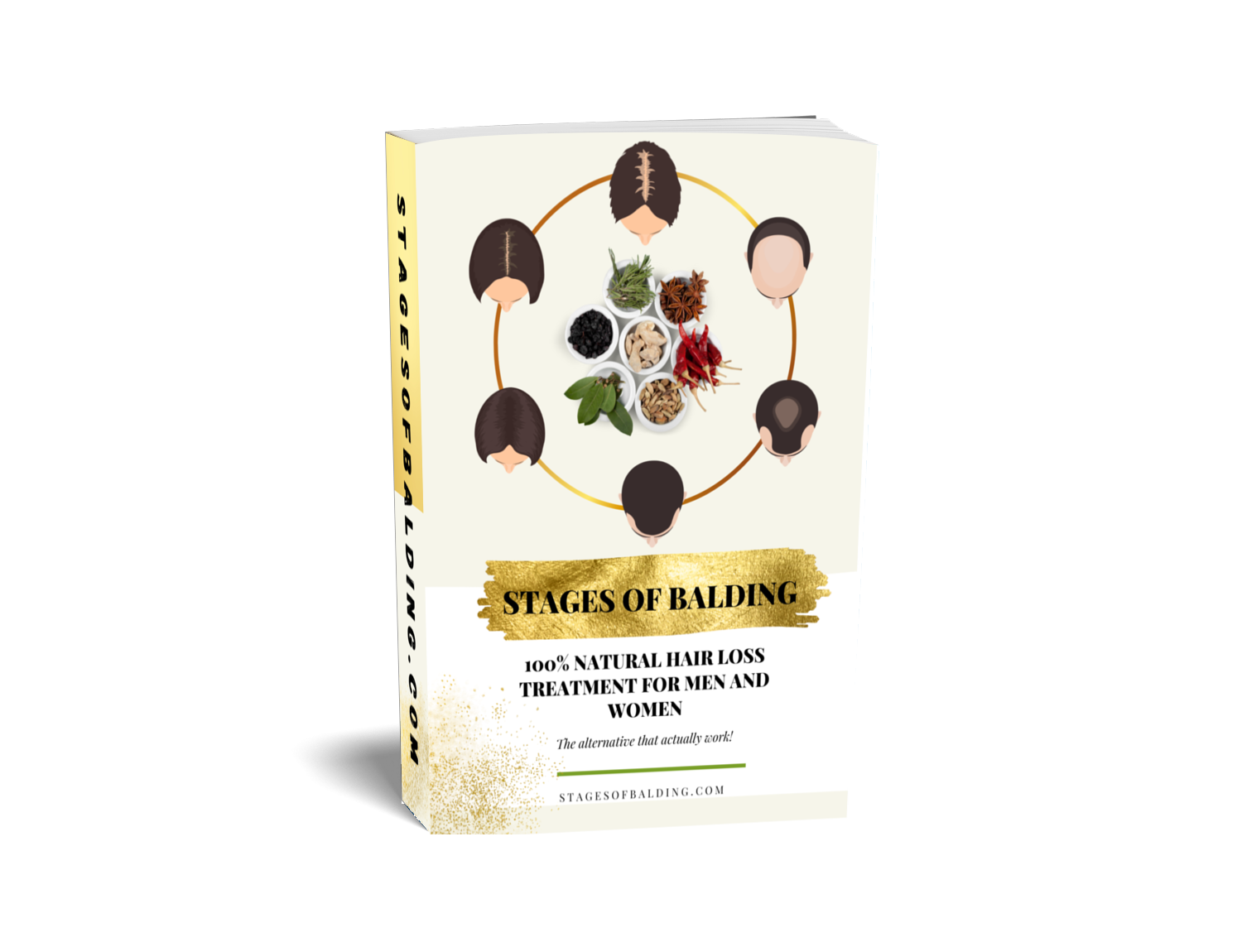
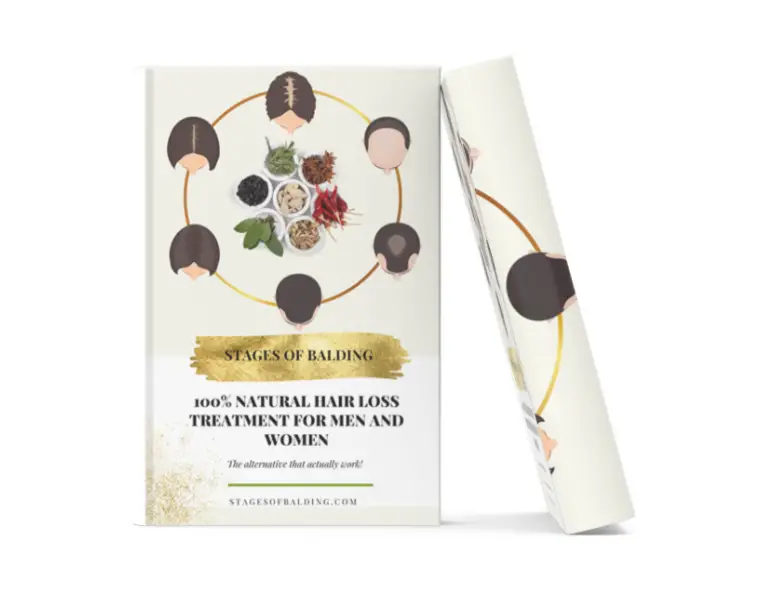


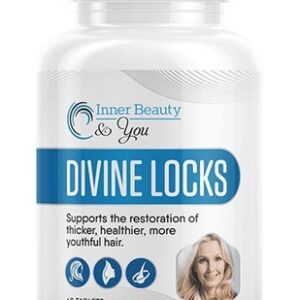
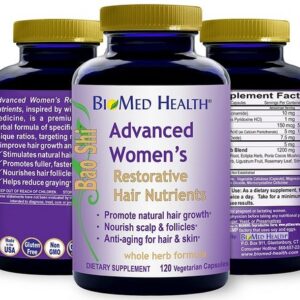


Reviews
There are no reviews yet.